Table of Contents
- Understanding the Foundation: Why Your Wellness Center Needs a Stellar Website
- The Digital Doorway: Your First Impression
- Building Trust and Credibility: Showcase Your Expertise
- Driving Bookings and Revenue: Turning Visitors into Clients
- The Power of Local SEO: Connecting with Your Community
- Defining Your Brand and Target Audience: Laying the Groundwork
- Identifying Your Niche: What Makes You Unique?
- Understanding Your Ideal Client: Who Are You Trying to Reach?
- Defining Your Brand Identity: Communicating Your Values
- Choosing the Right Platform: Building a Solid Foundation
- Website Builders vs. CMS: Weighing Your Options
- WordPress: The King of Content Management
- Key Considerations When Choosing a Platform:
- Designing an Engaging Website: Creating a Visually Appealing Experience
- User-Friendly Navigation: Guiding Visitors to the Right Place
- Compelling Visuals: Showcasing Your Wellness Center
- Mobile-First Design: Reaching Users on the Go
- Accessibility: Ensuring Inclusivity
- Essential Website Pages: Providing Key Information
- Homepage: Making a Strong First Impression
- About Us Page: Sharing Your Story
- Services Page: Describing Your Offerings
- Contact Us Page: Making It Easy to Connect
- Blog Page: Providing Valuable Content
- Integrating Online Booking: Streamlining Appointments
- Choosing the Right Booking System: Key Features to Look For
- Popular Online Booking Platforms:
- Embedding the Booking System: A Seamless Integration
- Search Engine Optimization (SEO): Getting Found Online
- Keyword Research: Finding the Right Terms
- On-Page Optimization: Making Your Website Search Engine Friendly
- Off-Page Optimization: Building Authority and Reputation
- Local SEO: Targeting Your Community
- Promoting Your Website: Driving Traffic and Engagement
- Social Media Marketing: Connecting with Your Audience
- Email Marketing: Nurturing Leads and Retaining Clients
- Content Marketing: Providing Value and Building Authority
- Paid Advertising: Reaching a Wider Audience
- Monitoring and Analyzing: Tracking Your Progress
- Google Analytics: Understanding Your Website Traffic
- Google Search Console: Monitoring Your Website’s Performance in Search Results
- A/B Testing: Optimizing Your Website for Conversions
- Qrolic Technologies: Your Partner in Digital Success
- Keeping Your Website Fresh: Ongoing Maintenance and Updates
- Regular Content Updates: Staying Relevant
- Software Updates: Security and Functionality
- Security Monitoring: Protecting Your Data
- Conclusion: Building a Thriving Online Presence
Understanding the Foundation: Why Your Wellness Center Needs a Stellar Website
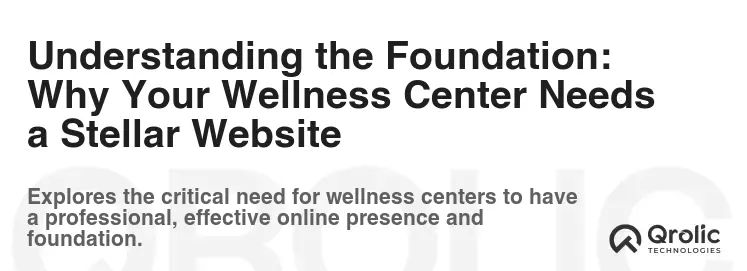
The Digital Doorway: Your First Impression
In today’s world, your website is often the first interaction potential clients have with your wellness center. It’s not just an online brochure; it’s a digital storefront, a 24/7 ambassador, and a crucial tool for attracting and retaining clients. Think of it as the online embodiment of the calm, rejuvenating atmosphere you cultivate in your physical space. A poorly designed website can be a major deterrent, driving potential clients to competitors with a more polished and user-friendly online presence.
- User expectations are high: People expect a professional, informative, and easy-to-navigate website. Anything less can damage your credibility.
- First impressions matter: You have seconds to capture a visitor’s attention and convince them that your wellness center is the right choice for their needs.
- Your website is your brand voice: It communicates your values, your expertise, and the unique benefits of your services.
Building Trust and Credibility: Showcase Your Expertise
A well-designed website establishes trust and credibility. It allows you to showcase your team’s qualifications, certifications, and experience, assuring potential clients that they’re in capable hands. By providing valuable content, such as blog posts and articles on wellness topics, you position yourself as an authority in the field. This is a key element of a strong health spa design.
- Highlight your team’s qualifications: Showcase certifications, licenses, and years of experience to build confidence.
- Share client testimonials and success stories: Social proof is incredibly powerful in convincing potential clients.
- Publish valuable content: Blog posts, articles, and videos demonstrate your expertise and attract organic traffic.
Driving Bookings and Revenue: Turning Visitors into Clients
Ultimately, your website should drive bookings and revenue. It should make it easy for visitors to learn about your services, check availability, and schedule appointments. Integrating online booking systems streamlines the process and reduces the friction that can lead to lost opportunities.
- Online booking systems: Make it easy for clients to schedule appointments 24/7.
- Clear calls to action: Guide visitors towards booking, contacting you, or learning more about your services.
- Promote special offers and packages: Incentivize bookings and increase revenue.
The Power of Local SEO: Connecting with Your Community
A strategically optimized website is crucial for local SEO. By targeting relevant keywords and optimizing your Google My Business listing, you can ensure that your wellness center appears in local search results, connecting you with potential clients in your community. Think “massage therapy near me” or “best facial spa in [city]”.
- Target local keywords: Optimize your website content with keywords that reflect your location and services.
- Optimize your Google My Business listing: Ensure your business information is accurate and up-to-date.
- Encourage online reviews: Positive reviews improve your search ranking and build trust.
Defining Your Brand and Target Audience: Laying the Groundwork
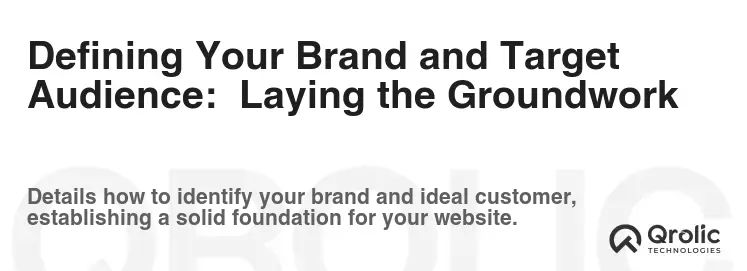
Identifying Your Niche: What Makes You Unique?
Before you start building your website, it’s essential to define your brand and target audience. What makes your wellness center unique? What specific needs do you cater to? Understanding your niche allows you to tailor your website content and design to resonate with your ideal clients. This is fundamental to any effective wellness center website strategy.
- Specialized services: Do you focus on massage therapy, acupuncture, yoga, or a combination of services?
- Target demographic: Are you targeting young professionals, seniors, athletes, or a specific gender?
- Unique selling proposition: What sets you apart from the competition? Is it your specialized expertise, your luxurious atmosphere, or your commitment to holistic wellness?
Understanding Your Ideal Client: Who Are You Trying to Reach?
Create detailed profiles of your ideal clients, considering their demographics, psychographics, and needs. This understanding will guide your website design, content, and marketing efforts. Consider their pain points, motivations, and online behavior.
- Demographics: Age, gender, location, income, education.
- Psychographics: Values, interests, lifestyle, attitudes.
- Needs and pain points: What are they struggling with? How can your wellness center help?
- Online behavior: Where do they spend their time online? What types of content do they consume?
Defining Your Brand Identity: Communicating Your Values
Your brand identity should be reflected in every aspect of your website, from the logo and color scheme to the tone of voice and imagery. It should communicate your values, your personality, and the unique experience you offer.
- Logo and color scheme: Choose a logo and color palette that reflect your brand’s personality and appeal to your target audience.
- Tone of voice: Establish a consistent tone of voice that is both professional and approachable.
- Imagery: Use high-quality images and videos that showcase your wellness center, your team, and the benefits of your services.
- Mission statement: Clearly articulate your mission and values on your website.
Choosing the Right Platform: Building a Solid Foundation
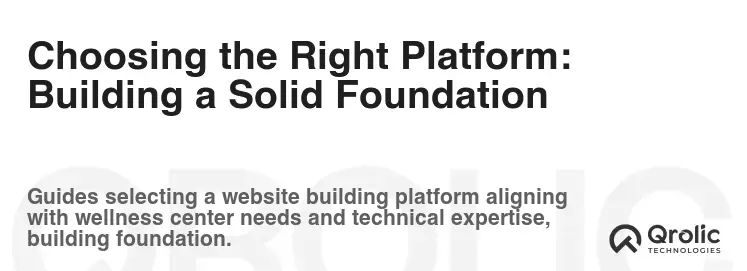
Website Builders vs. CMS: Weighing Your Options
You have several options when it comes to choosing a platform for your website. The two most popular choices are website builders (like Wix, Squarespace, and Weebly) and Content Management Systems (CMS) like WordPress.
Website Builders:
- Pros: Easy to use, drag-and-drop interface, no coding required, all-in-one solution.
- Cons: Limited customization options, less control over your website’s code, can be more expensive in the long run.
- Best for: Wellness centers with limited technical expertise and simple website needs.
Content Management Systems (CMS):
- Pros: Highly customizable, extensive library of plugins and themes, full control over your website’s code, more scalable.
- Cons: Requires some technical expertise, steeper learning curve, requires more maintenance.
- Best for: Wellness centers that need a highly customizable website with advanced features and long-term scalability.
WordPress: The King of Content Management
WordPress is the most popular CMS in the world, powering over 40% of all websites. It’s a powerful and flexible platform that offers a wide range of customization options and a vast library of plugins and themes. For a wellness center website, WordPress provides the perfect blend of functionality and design freedom.
- Extensive theme library: Choose from thousands of free and premium themes specifically designed for wellness centers and spas.
- Powerful plugins: Extend the functionality of your website with plugins for online booking, appointment scheduling, e-commerce, and more.
- SEO-friendly: WordPress is inherently SEO-friendly, making it easier to rank your website in search results.
- Scalable: WordPress can grow with your business, allowing you to add new features and functionality as needed.
Key Considerations When Choosing a Platform:
- Ease of use: How easy is it to learn and use the platform?
- Customization options: How much control do you have over the design and functionality of your website?
- SEO capabilities: How SEO-friendly is the platform?
- Scalability: Can the platform grow with your business?
- Cost: What are the upfront and ongoing costs associated with the platform?
Designing an Engaging Website: Creating a Visually Appealing Experience
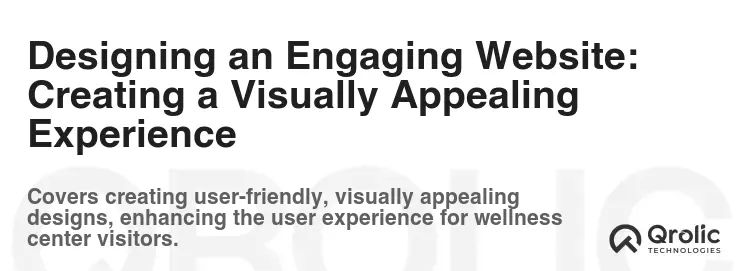
User-Friendly Navigation: Guiding Visitors to the Right Place
Your website’s navigation should be intuitive and easy to use, guiding visitors to the information they need quickly and efficiently. A clear and logical navigation structure is essential for a positive user experience.
- Simple menu structure: Limit the number of menu items to avoid overwhelming visitors.
- Descriptive labels: Use clear and concise labels that accurately describe the content of each page.
- Search functionality: Provide a search bar to allow visitors to quickly find specific information.
- Mobile-friendly design: Ensure your website is responsive and looks great on all devices.
Compelling Visuals: Showcasing Your Wellness Center
High-quality images and videos are essential for showcasing your wellness center and creating a visually appealing experience. Use professional photos of your space, your team, and your clients (with their permission).
- Professional photography: Invest in professional photography to capture the essence of your wellness center.
- Videos: Create videos that showcase your services, your team, and the benefits of your offerings.
- Optimized images: Optimize your images for web use to reduce file size and improve loading speed.
Mobile-First Design: Reaching Users on the Go
With the majority of website traffic coming from mobile devices, it’s crucial to prioritize mobile-first design. Ensure your website is responsive and provides a seamless experience on all screen sizes. This is critical for a successful health spa design online presence.
- Responsive design: Your website should automatically adapt to different screen sizes.
- Touch-friendly navigation: Make it easy for users to navigate your website on touchscreens.
- Fast loading speed: Optimize your website for fast loading speed on mobile devices.
Accessibility: Ensuring Inclusivity
Ensure your website is accessible to users with disabilities by following accessibility guidelines such as WCAG (Web Content Accessibility Guidelines). This includes providing alternative text for images, using sufficient color contrast, and ensuring that your website is navigable using a keyboard.
- Alternative text for images: Provide descriptive alternative text for all images.
- Sufficient color contrast: Ensure there is sufficient color contrast between text and background.
- Keyboard navigation: Ensure your website is navigable using a keyboard.
- Screen reader compatibility: Test your website with screen readers to ensure it is accessible to visually impaired users.
Essential Website Pages: Providing Key Information
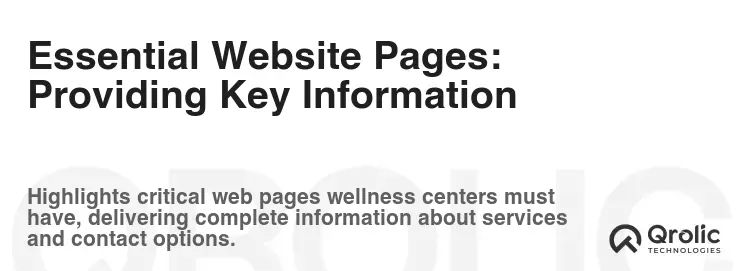
Homepage: Making a Strong First Impression
Your homepage is the most important page on your website. It should capture visitors’ attention, communicate your brand’s value proposition, and guide them towards the information they need.
- Compelling headline: Use a headline that clearly communicates the benefits of your services.
- High-quality images and videos: Showcase your wellness center and your team.
- Clear calls to action: Encourage visitors to book an appointment, contact you, or learn more about your services.
- Testimonials: Include testimonials from satisfied clients to build trust.
About Us Page: Sharing Your Story
The About Us page is your opportunity to share your story, your values, and your team’s expertise. It helps build trust and connect with potential clients on a personal level.
- Share your mission and vision: Clearly articulate your mission and vision for your wellness center.
- Introduce your team: Showcase your team’s qualifications, experience, and passion for wellness.
- Tell your story: Share the story of how your wellness center was founded and what makes it unique.
- Include photos and videos: Visually showcase your team and your wellness center.
Services Page: Describing Your Offerings
The Services page should provide detailed information about each of your services, including pricing, benefits, and what to expect during a session. Make sure the wellness center website details the experience.
- Clear and concise descriptions: Use clear and concise descriptions that are easy to understand.
- Pricing information: Clearly display pricing information for each service.
- Benefits of each service: Highlight the benefits of each service to potential clients.
- Call to action: Encourage visitors to book an appointment or learn more about a specific service.
Contact Us Page: Making It Easy to Connect
The Contact Us page should make it easy for visitors to get in touch with you, providing your phone number, email address, physical address, and a contact form.
- Phone number and email address: Clearly display your phone number and email address.
- Physical address: Provide your physical address and a map to your wellness center.
- Contact form: Include a contact form to allow visitors to send you a message directly.
- Social media links: Include links to your social media profiles.
Blog Page: Providing Valuable Content
A blog page allows you to share valuable content with your audience, positioning yourself as an authority in the field and attracting organic traffic to your website.
- Publish informative articles: Share articles on wellness topics, tips, and advice.
- Target relevant keywords: Optimize your blog posts with keywords that reflect your services and target audience.
- Promote your services: Incorporate your services into your blog posts naturally.
- Engage with your audience: Encourage comments and feedback from your readers.
Integrating Online Booking: Streamlining Appointments
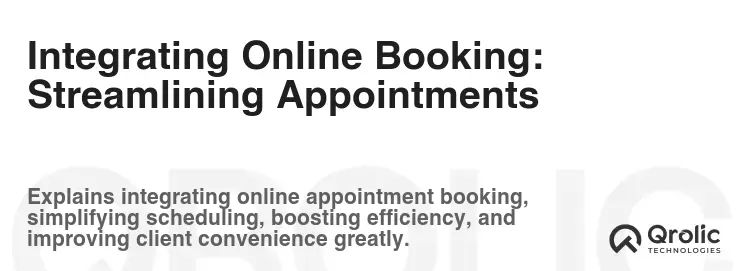
Choosing the Right Booking System: Key Features to Look For
Integrating an online booking system into your website can significantly streamline your appointment scheduling process and improve the client experience. Look for a system that integrates seamlessly with your website and offers the features you need, like:
- Real-time availability: Show real-time availability to avoid double bookings and scheduling conflicts.
- Appointment reminders: Send automated appointment reminders to reduce no-shows.
- Online payments: Allow clients to pay for their appointments online.
- Staff management: Manage staff schedules and availability.
- Reporting and analytics: Track your bookings and revenue.
Popular Online Booking Platforms:
- Acuity Scheduling: A popular choice for wellness centers, offering a wide range of features and integrations.
- Mindbody: A comprehensive platform designed specifically for the health and wellness industry.
- Booker: Another comprehensive option with marketing and client management tools.
- Square Appointments: An easy-to-use and affordable option, especially if you already use Square for payment processing.
Embedding the Booking System: A Seamless Integration
Ensure the booking system is seamlessly integrated into your website, providing a user-friendly experience. The booking process should be intuitive and easy to navigate.
- Clear call to action: Make it easy for visitors to find the booking system and schedule an appointment.
- Mobile-friendly design: Ensure the booking system is responsive and looks great on all devices.
- Secure payment processing: Ensure the payment process is secure and protects client data.
Search Engine Optimization (SEO): Getting Found Online
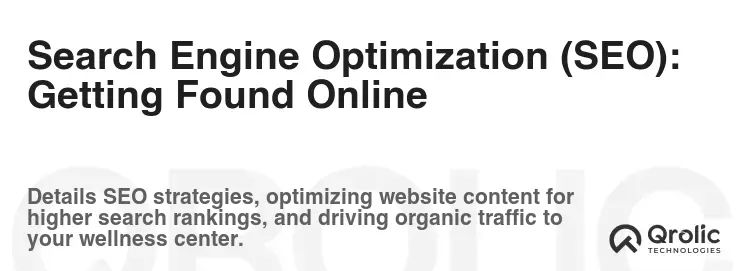
Keyword Research: Finding the Right Terms
Keyword research is the foundation of any successful SEO strategy. Identify the keywords that your target audience is using to search for wellness centers and services in your area. This will help you optimize your website content and attract organic traffic.
- Brainstorming: Start by brainstorming a list of keywords related to your services and location.
- Keyword research tools: Use keyword research tools like Google Keyword Planner, SEMrush, or Ahrefs to identify high-volume, low-competition keywords.
- Local keywords: Focus on local keywords that include your city or region, such as “massage therapy [city]” or “wellness center [city]”.
On-Page Optimization: Making Your Website Search Engine Friendly
On-page optimization involves optimizing your website content and code to improve its ranking in search results.
- Title tags: Optimize your title tags with relevant keywords.
- Meta descriptions: Write compelling meta descriptions that encourage users to click on your website in search results.
- Header tags: Use header tags (H1, H2, H3, etc.) to structure your content and highlight important keywords.
- Content optimization: Optimize your website content with relevant keywords and provide valuable information to your audience.
- Image optimization: Optimize your images with descriptive alt text and compress them to reduce file size.
- Internal linking: Link to other relevant pages on your website to improve navigation and SEO.
Off-Page Optimization: Building Authority and Reputation
Off-page optimization involves building authority and reputation for your website by getting links from other websites.
- Link building: Earn links from reputable websites in your industry and local community.
- Directory listings: List your wellness center in online directories such as Yelp, Google My Business, and Healthgrades.
- Social media marketing: Promote your website and content on social media.
- Online reviews: Encourage clients to leave positive reviews on sites like Google, Yelp, and Facebook. Positive reviews increase your website’s credibility in the eyes of Google.
Local SEO: Targeting Your Community
Local SEO is crucial for attracting clients in your local community.
- Google My Business: Claim and optimize your Google My Business listing.
- Local citations: List your business in local directories and websites.
- Online reviews: Encourage clients to leave reviews on Google and other review sites.
- Local keywords: Target local keywords in your website content and marketing efforts.
Promoting Your Website: Driving Traffic and Engagement
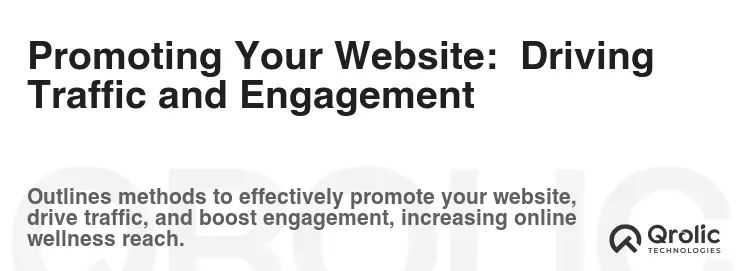
Social Media Marketing: Connecting with Your Audience
Social media marketing is a powerful tool for connecting with your audience, promoting your services, and driving traffic to your website.
- Choose the right platforms: Focus on the platforms where your target audience is most active.
- Share valuable content: Share informative articles, tips, and advice related to wellness.
- Engage with your audience: Respond to comments and messages, and participate in relevant conversations.
- Run targeted ads: Use social media advertising to reach a wider audience and promote your services.
Email Marketing: Nurturing Leads and Retaining Clients
Email marketing is an effective way to nurture leads, promote special offers, and retain existing clients.
- Build an email list: Offer a free ebook, a discount, or other incentives to encourage visitors to sign up for your email list.
- Segment your list: Segment your list based on interests, demographics, and purchase history.
- Send targeted emails: Send targeted emails with relevant content and offers.
- Automate your emails: Automate your email marketing with tools like Mailchimp or ConvertKit.
Content Marketing: Providing Value and Building Authority
Content marketing involves creating and sharing valuable content to attract and engage your target audience.
- Blog posts: Write informative blog posts on wellness topics.
- Ebooks: Create ebooks that provide in-depth information on specific topics.
- Infographics: Create visually appealing infographics that present complex information in an easy-to-understand format.
- Videos: Create videos that showcase your services, your team, and the benefits of your offerings.
- Podcasts: Create podcasts that feature interviews with experts and discussions on wellness topics.
Paid Advertising: Reaching a Wider Audience
Paid advertising can be an effective way to reach a wider audience and drive traffic to your website.
- Google Ads: Use Google Ads to target users who are searching for wellness centers and services in your area.
- Social media advertising: Use social media advertising to reach a wider audience and promote your services on platforms like Facebook, Instagram, and LinkedIn.
- Retargeting ads: Use retargeting ads to target users who have visited your website but haven’t yet booked an appointment.
Monitoring and Analyzing: Tracking Your Progress
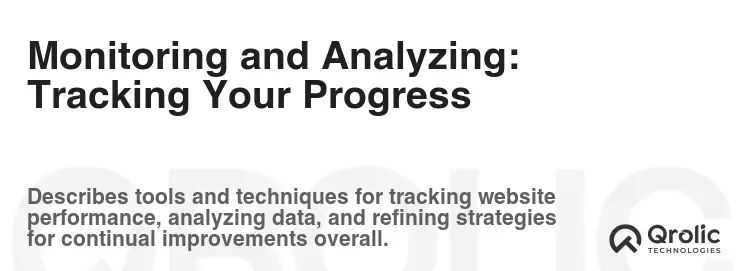
Google Analytics: Understanding Your Website Traffic
Google Analytics is a powerful tool for tracking your website traffic, understanding user behavior, and measuring the effectiveness of your marketing efforts.
- Track website traffic: Monitor the number of visitors to your website, where they are coming from, and what pages they are visiting.
- Analyze user behavior: Understand how users are interacting with your website, how long they are spending on each page, and what actions they are taking.
- Measure conversions: Track the number of users who are booking appointments, contacting you, or signing up for your email list.
- Identify areas for improvement: Identify areas where you can improve your website design, content, and marketing efforts.
Google Search Console: Monitoring Your Website’s Performance in Search Results
Google Search Console provides valuable insights into how your website is performing in Google search results.
- Track your search ranking: Monitor your website’s ranking for relevant keywords.
- Identify crawl errors: Identify and fix any crawl errors that are preventing Google from indexing your website.
- Submit sitemaps: Submit sitemaps to help Google crawl and index your website more efficiently.
- Monitor backlinks: Monitor the backlinks pointing to your website.
A/B Testing: Optimizing Your Website for Conversions
A/B testing (also known as split testing) involves testing different versions of your website to see which one performs better.
- Test different headlines: Test different headlines to see which one attracts more attention.
- Test different calls to action: Test different calls to action to see which one generates more conversions.
- Test different images: Test different images to see which one resonates best with your audience.
- Test different layouts: Test different layouts to see which one provides the best user experience.
Qrolic Technologies: Your Partner in Digital Success

At Qrolic Technologies, we understand the unique challenges and opportunities that wellness centers face in the digital world. We offer a comprehensive suite of digital marketing services to help you build a strong online presence, attract new clients, and grow your business.
- Website Design and Development: We create beautiful, user-friendly websites that are optimized for search engines and designed to convert visitors into clients. We deeply understand health spa design nuances and can translate the physical experience to the digital realm.
- Search Engine Optimization (SEO): We help you rank higher in search results, driving organic traffic to your website and connecting you with potential clients in your local community.
- Social Media Marketing: We manage your social media presence, creating engaging content and running targeted ads to reach your ideal audience.
- Pay-Per-Click (PPC) Advertising: We create and manage effective PPC campaigns that drive targeted traffic to your website and generate leads.
- Content Marketing: We create valuable content that attracts and engages your target audience, positioning you as an authority in the wellness industry.
- Email Marketing: We help you build an email list and send targeted emails to nurture leads and retain existing clients.
We are committed to providing our clients with exceptional service and delivering measurable results. Contact us today to learn more about how we can help you achieve your digital marketing goals.
Keeping Your Website Fresh: Ongoing Maintenance and Updates

Regular Content Updates: Staying Relevant
Keep your website fresh and relevant by regularly updating your content with new blog posts, articles, and videos.
- Maintain a consistent publishing schedule: Establish a consistent publishing schedule to keep your audience engaged.
- Update old content: Review and update old content to ensure it is still accurate and relevant.
Software Updates: Security and Functionality
Keep your website software up to date to ensure its security and functionality. This includes updating your CMS, plugins, and themes.
- Enable automatic updates: Enable automatic updates whenever possible.
- Test updates before implementing them: Test updates on a staging environment before implementing them on your live website.
Security Monitoring: Protecting Your Data
Protect your website from hackers and malware by implementing security measures such as a firewall, regular backups, and strong passwords.
- Install a security plugin: Install a security plugin to protect your website from common threats.
- Use strong passwords: Use strong, unique passwords for all of your website accounts.
- Back up your website regularly: Back up your website regularly to protect your data in case of a security breach.
Conclusion: Building a Thriving Online Presence
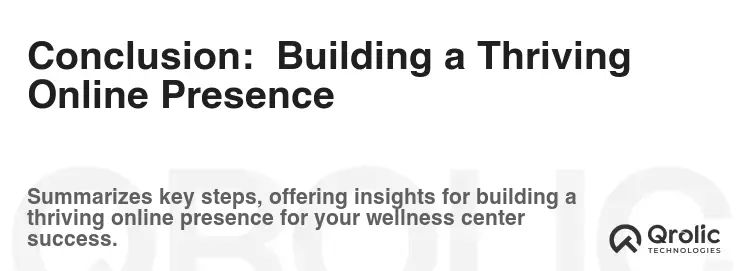
Creating a successful wellness center website requires careful planning, thoughtful design, and ongoing maintenance. By following the tips and strategies outlined in this comprehensive guide, you can build a thriving online presence that attracts new clients, strengthens your brand, and drives revenue. Remember to focus on providing value to your audience, creating a user-friendly experience, and optimizing your website for search engines. By investing in your online presence, you can position your wellness center for long-term success. A well-designed wellness center website is an investment in your future.





